Topics
Category
Era
Fort Ripley
Fort Ripley was a nineteenth-century army outpost located on the upper Mississippi River in north-central Minnesota. It was situated near government agencies for the Ho-Chunk and Ojibwe. By its very presence, however, the fort spurred immigration into the area by whites.
Fort Ripley typified remote army posts during the mid-nineteenth century. The buildings were wooden, facing a quadrangle. It was on a navigable river and an important supply route. It was geographically remote from European-American population centers, but American Indians lived nearby.
The Fort was built because the Ho-Chunk (Winnebago) had been moved from northeastern Iowa to a new reservation near Long Prairie, necessitating a military post nearby to guard the reservation and administer annuity payments. The government also hoped that the Ho-Chunk, and the fort, would serve as a buffer between the warring Eastern Dakota and Ojibwe. Construction began in November 1848. In April 1849, Company A of the Sixth United States Infantry arrived to take up quarters under the command of Captain John B. Todd. The post, initially named Fort Marcy, was briefly renamed Fort Gaines and in 1850 was renamed again after Brigadier General Eleazar W. Ripley, a distinguished soldier from the War of 1812.
With occasional exceptions, daily life at Fort Ripley was uneventful. The geographic isolation, summer mosquitoes, and long, cold winters challenged everyone on post. Twice each year, the soldiers marched to the Long Prairie Agency to supervise government annuity payments of money and goods to the Ho-Chunk and then did the same for the Ojibwe at the Crow Wing Agency.
In 1855, the Ho-Chunk were moved again—this time to a reservation in Blue Earth County. Thinking the post was no longer needed, the army withdrew the garrison in 1857. Almost immediately, disturbances broke out between white immigrants and some Ojibwe, prompting reactivation of the fort.
Typical of nineteenth century army posts, Fort Ripley’s military reservation was huge. It encompassed nearly ninety square miles on the east side of the Mississippi, plus only a single square mile on the west side to house the garrison. This unusual configuration, chosen because the Ho-Chunk reservation abutted the west side of the river, caused much agitation among those who wanted the unused east side opened to homesteaders. The army agreed in 1857 to sell it in public auction, but local farmers, by mutual pact, underbid the property. The Secretary of War annulled the sale. In the meantime, however, many purchasers had begun to build homes and farm the land. The resulting confusion and litigation took twenty years to untangle.
Military activity on the post intensified during the Civil War (1861–1865). Army regulars—sent south to fight Confederates—were replaced by companies detached from Minnesota’s volunteer regiments.
Despite an undercurrent of mistrust, relations between European-Americans and Ojibwes had largely been peaceful in Minnesota. That nearly changed when the U.S.–Dakota War of 1862 broke out. Seizing upon that conflict as an opportunity to gain power and leverage for redress of grievances, Ojibwe leader Bagone-giizhig (Hole-in-the Day II) threatened to launch a simultaneous war in northern Minnesota. Fearful whites in the area flocked to Fort Ripley for protection. Additional soldiers were rushed in and the post was readied for battle.
The threat was defused, thanks to cool-headed negotiating and the garrison’s strengthened defenses. For the next three years Fort Ripley became a base for western military campaigns that came on the heels of the U.S.-Dakota War. Activity reached its peak during the winter of 1863–1864, when four hundred cavalry troops and five hundred horses were quartered at the fort.
On a sub-zero night in January 1877, fire destroyed three buildings. Believing the post had outlived its purpose, the War Department decided to permanently close it rather than rebuild. The troops moved out that summer. The buildings stood abandoned for many years. By 1910, the ruins of the powder magazine, built of stone, were all that remained.
In 1929, the State of Minnesota announced that a new National Guard training site would be built in central Minnesota. The land had to be purchased and, purely by coincidence, the remains of old Fort Ripley were within the proposed boundaries. The new post—Camp Ripley—took its name from the old.
Bibliography
Baker, Robert Orr. The Muster Roll – A Biography of Fort Ripley Minnesota. St. Paul: H.M. Smyth Co., 1972.
Diedrich, Mark. "Chief Hole-in-the-Day and the 1862 Chippewa Disturbance: A Reappraisal." Minnesota History 50, no. 5 (Spring 1987): 193–203.
http://collections.mnhs.org/MNHistoryMagazine/articles/50/v50i05p193-203.pdf
Folwell, William Watts. A History of Minnesota. Vol. 2. St. Paul: Minnesota Historical Society, 1961.
Prucha, F. Paul. “Fort Ripley: The Post and the Military Reservation.” Minnesota History 28, no.3 (September 1947): 205–224.
http://collections.mnhs.org/MNHistoryMagazine/articles/28/v28i03p205-224.pdf
Tanner, George C. “History of Fort Ripley, 1849–1859: Based on the Diary of Rev. Solon W. Manney, D.D. Chaplain of this post from 1851 to 1859.” Collections of the Minnesota Historical Society 10, pt. 1 (1905): 179–202.
http://anglicanhistory.org/usa/mn/manney_ripley.html
Related Resources
Primary
Derby. Sketch of the Site selected by Gen’ Brooke for a Fortification, opposite the mouth of the Nokay River. Minneapolis: U.S. Army, September 24, 1848.
Jordan, Philip D. "A Wit Looks at Old Fort Ripley," Minnesota History 28, no.4 (1947): 339–344.
http://collections.mnhs.org/MNHistoryMagazine/articles/28/v28i04p339-344.pdf
Secondary
Baker, Robert Orr. “The Building of Old Fort Ripley and Its Links With St. Paul.” Ramsey County History 8, no. 1 (1971): 8–11.
Barnes, Jeff. “Fort Ripley.” In Forts of the Northern Plains: A Guide to the Historic Military Posts of the Plains Indians Wars, 23–27. Mechanicsburg, PA: Stackpole Books, 2008.
Field, Ron. Forts of the American Frontier, 1820–91: Central and Northern Plains. Oxford: Osprey Publishing, 2005.
Johnson, Jack K. “History of Old Fort Ripley, 1848–1877.” Little Falls, MN: Minnesota Military Museum, 2015.
http://www.mnmilitarymuseum.org/files/1214/5504/3510/Revised_Old_Ft_Ripley_3.pdf
Prucha, Francis Paul. “The Army Post on the Minnesota Frontier 1819–1882.” Master’s Thesis, University of Minnesota, March 1947.
——— . A Guide to the Military Posts of the United States, 1789–1895. Madison, WI: State Historical Society of Wisconsin, 1964. (2nd printing, 1966, includes corrections.)
Rickey, Don Jr. Forty Miles a Day on Beans and Hay: The Enlisted Soldier Fighting the Indian Wars. Norman, OK: University of Oklahoma Press, 1963.
Treuer, Anton. The Assassination of Hole in the Day. St. Paul: Borealis Books, 2011.
Web
Minnesota Military Museum. About Camp Ripley.
http://www.mnmilitarymuseum.org/index.php/visit/about-camp-ripley/
Minnesota National Guard. Camp Ripley Training Center.
http://www.minnesotanationalguard.org/camp_ripley/
Related Images
Map of Fort Ripley as surveyed in 1874, showing the ninety square miles of reservation land on the east side of the river and one square mile for the actual post on the west side. The sale of parcels on the east side in 1857, and subsequent annulment of the sale, created legal problems that took twenty years to untangle. (From 46 Congress, 2 session, Senate Reports, no. 196, serial 1893.)
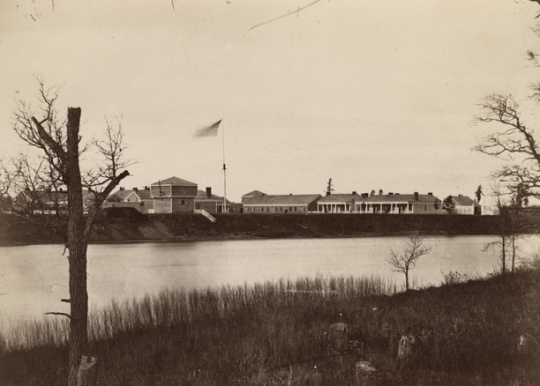
Fort Ripley
Public domain
Holding Location
Articles
More Information
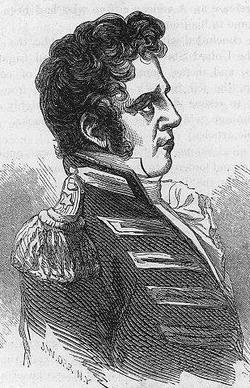
Brigadier General Eleazar Wheelock Ripley
Brigadier General Eleazar Wheelock Ripley. Fort Ripley is named for this general from the War of 1812. Unsigned engraving from Peterson, Charles, Jacob. Military Heroes of the War of 1812. Philadelphia: William A. Leary & Co., 1849.
Public domain
Articles
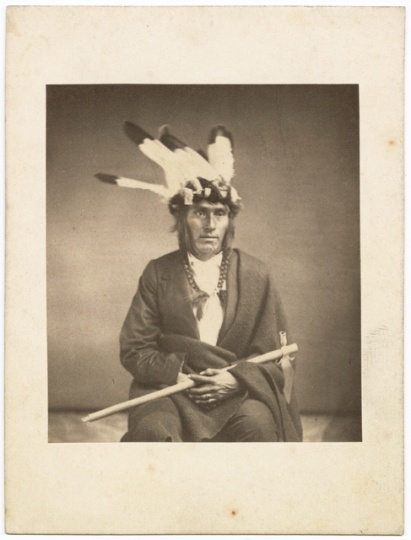
Bagone-giizhig (Hole-in-the-Day the younger)
Public domain
Holding Location
More Information
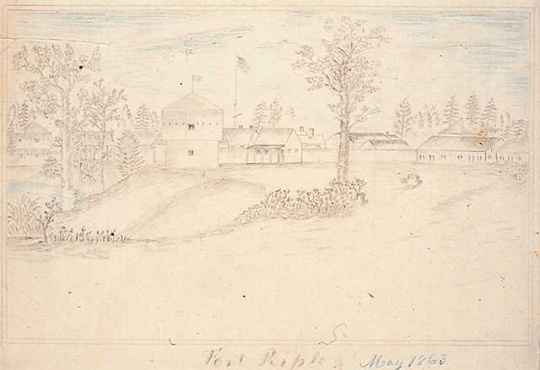
Graphite drawing of Fort Ripley
Public domain
Holding Location
Articles
More Information
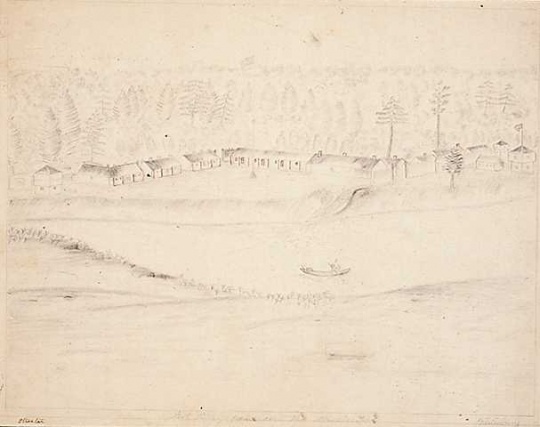
Graphite drawing of Fort Ripley from east the Mississippi
Public domain
Holding Location
Articles
More Information

Drawing of Fort Ripley
Public domain
Holding Location
Articles
More Information
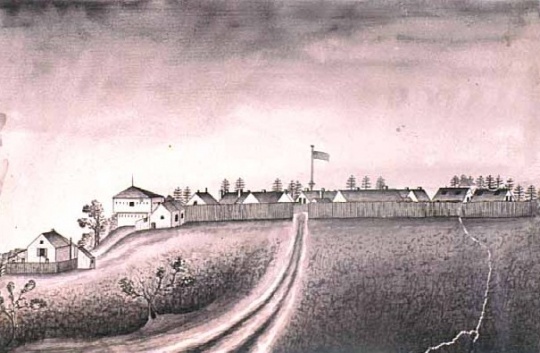
Drawing of Fort Ripley from the north
Public domain
Holding Location
Articles
More Information
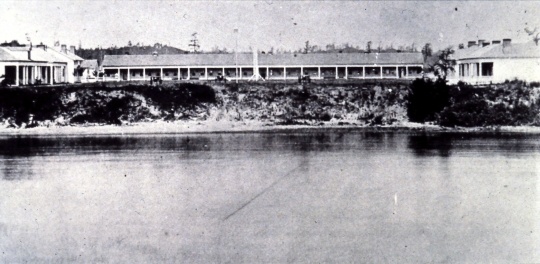
Fort Ripley in the early 1870s
Public domain
Holding Location
Articles
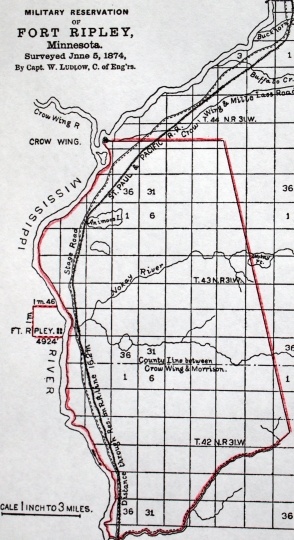
Map of Fort Ripley as surveyed in 1874
Map of Fort Ripley as surveyed in 1874, showing the ninety square miles of reservation land on the east side of the river and one square mile for the actual post on the west side. The sale of parcels on the east side in 1857, and subsequent annulment of the sale, created legal problems that took twenty years to untangle. (From 46 Congress, 2 session, Senate Reports, no. 196, serial 1893.)
Public domain
Articles
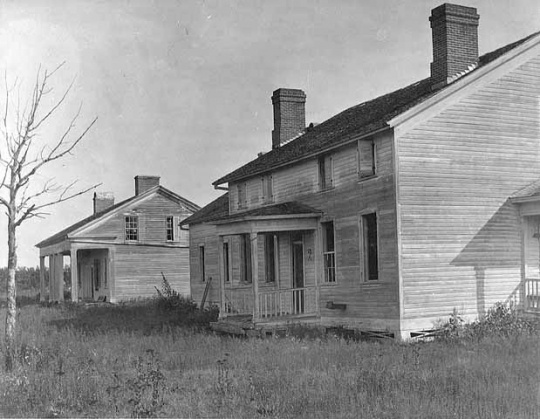
Abandoned Fort Ripley
Abandoned Fort Ripley, c.1895. On the left is one of the original officers’ quarters; in the foreground is the hospital and headquarters built to replace the original structure that had burned down in July 1870.
Public domain
Holding Location
Articles
More Information
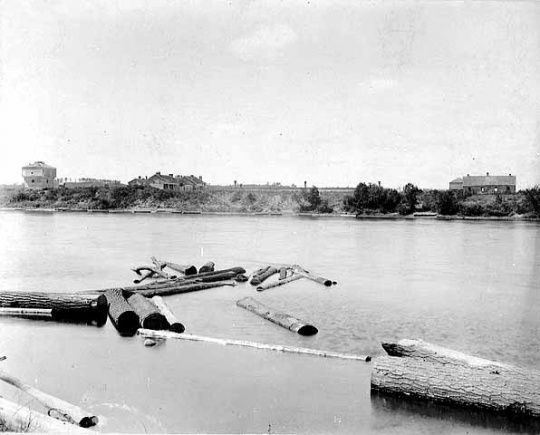
Abandoned Fort Ripley as seen from the east side of the Mississippi River
Public domain
Holding Location
Articles
More Information
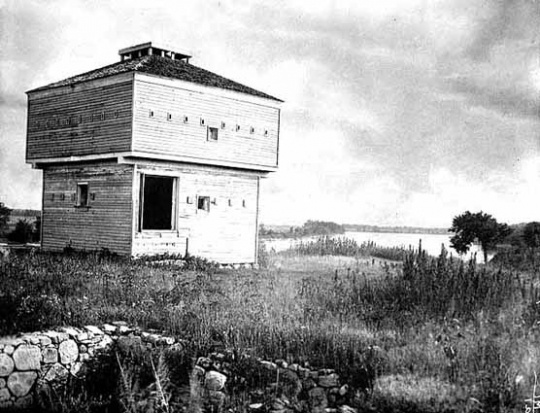
Blockhouse at abandoned Fort Ripley
Public domain
Holding Location
Articles
More Information
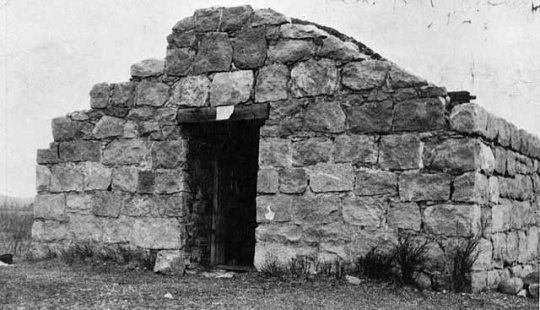
Powder house ruins at Fort Ripley
Articles
More Information
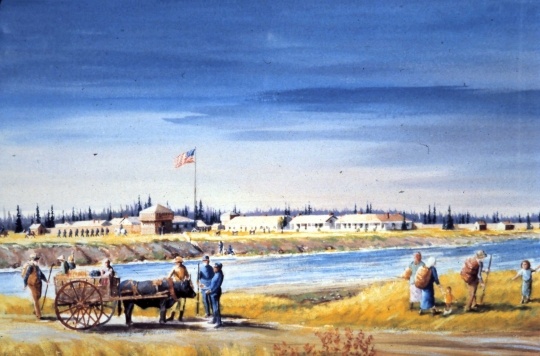
Watercolor of old Fort Ripley by Minnesota artist Paul S. Kramer
Holding Location
Articles
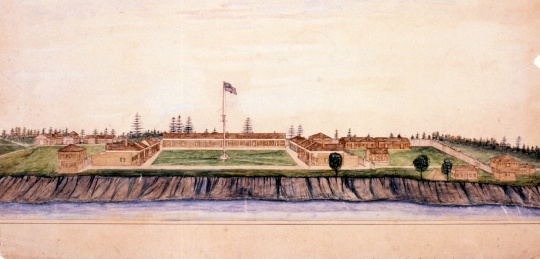
Watercolor of 1868 Fort Ripley by Col. Edward G. Bush
Holding Location
Articles
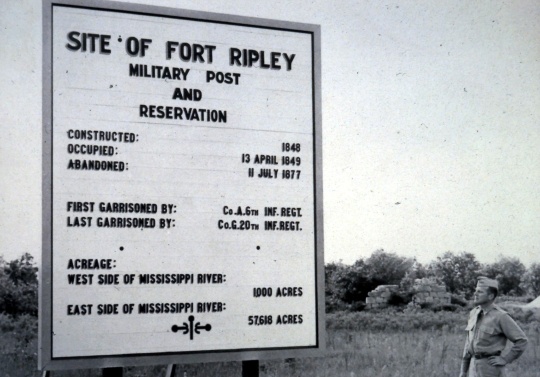
Fort Ripley sign
Public domain
Holding Location
Articles
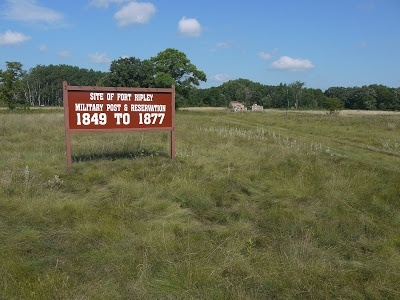
Sign marking the site of Fort Ripley
All rights reserved
Holding Location
Articles
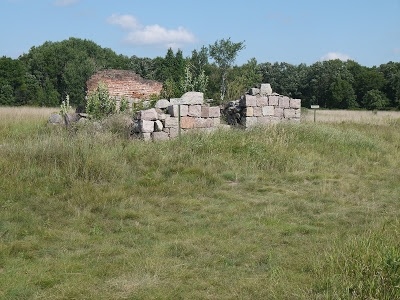
Remains of the Fort Ripley powder magazine
All rights reserved
Holding Location
Articles
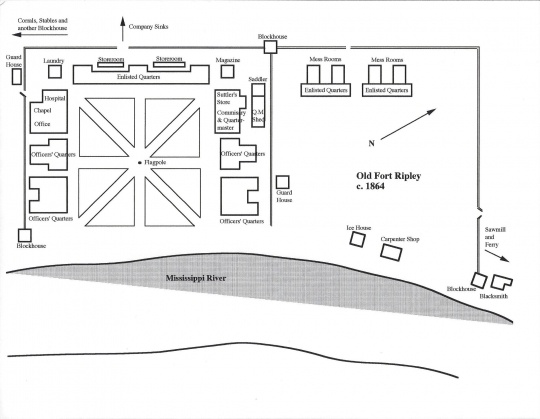
Building layout of Fort Ripley
All rights reserved
Holding Location
Articles
Related Articles
Turning Point
In August 1862, while a group of Dakota are attacking whites in southern Minnesota, a group of Ojibwe led by Bagone-giizhig (Hole-in-the Day II) threaten to do the same in northern Minnesota. Fort Ripley is hastily reinforced and hundreds of fearful whites flock to it for protection. For the next three years, the post becomes a beehive of military activity.
Chronology
1848
1849
1855
1857
1861
1862
1863
1864
1866
1877
1929
Bibliography
Baker, Robert Orr. The Muster Roll – A Biography of Fort Ripley Minnesota. St. Paul: H.M. Smyth Co., 1972.
Diedrich, Mark. "Chief Hole-in-the-Day and the 1862 Chippewa Disturbance: A Reappraisal." Minnesota History 50, no. 5 (Spring 1987): 193–203.
http://collections.mnhs.org/MNHistoryMagazine/articles/50/v50i05p193-203.pdf
Folwell, William Watts. A History of Minnesota. Vol. 2. St. Paul: Minnesota Historical Society, 1961.
Prucha, F. Paul. “Fort Ripley: The Post and the Military Reservation.” Minnesota History 28, no.3 (September 1947): 205–224.
http://collections.mnhs.org/MNHistoryMagazine/articles/28/v28i03p205-224.pdf
Tanner, George C. “History of Fort Ripley, 1849–1859: Based on the Diary of Rev. Solon W. Manney, D.D. Chaplain of this post from 1851 to 1859.” Collections of the Minnesota Historical Society 10, pt. 1 (1905): 179–202.
http://anglicanhistory.org/usa/mn/manney_ripley.html
Related Resources
Primary
Derby. Sketch of the Site selected by Gen’ Brooke for a Fortification, opposite the mouth of the Nokay River. Minneapolis: U.S. Army, September 24, 1848.
Jordan, Philip D. "A Wit Looks at Old Fort Ripley," Minnesota History 28, no.4 (1947): 339–344.
http://collections.mnhs.org/MNHistoryMagazine/articles/28/v28i04p339-344.pdf
Secondary
Baker, Robert Orr. “The Building of Old Fort Ripley and Its Links With St. Paul.” Ramsey County History 8, no. 1 (1971): 8–11.
Barnes, Jeff. “Fort Ripley.” In Forts of the Northern Plains: A Guide to the Historic Military Posts of the Plains Indians Wars, 23–27. Mechanicsburg, PA: Stackpole Books, 2008.
Field, Ron. Forts of the American Frontier, 1820–91: Central and Northern Plains. Oxford: Osprey Publishing, 2005.
Johnson, Jack K. “History of Old Fort Ripley, 1848–1877.” Little Falls, MN: Minnesota Military Museum, 2015.
http://www.mnmilitarymuseum.org/files/1214/5504/3510/Revised_Old_Ft_Ripley_3.pdf
Prucha, Francis Paul. “The Army Post on the Minnesota Frontier 1819–1882.” Master’s Thesis, University of Minnesota, March 1947.
——— . A Guide to the Military Posts of the United States, 1789–1895. Madison, WI: State Historical Society of Wisconsin, 1964. (2nd printing, 1966, includes corrections.)
Rickey, Don Jr. Forty Miles a Day on Beans and Hay: The Enlisted Soldier Fighting the Indian Wars. Norman, OK: University of Oklahoma Press, 1963.
Treuer, Anton. The Assassination of Hole in the Day. St. Paul: Borealis Books, 2011.
Web
Minnesota Military Museum. About Camp Ripley.
http://www.mnmilitarymuseum.org/index.php/visit/about-camp-ripley/
Minnesota National Guard. Camp Ripley Training Center.
http://www.minnesotanationalguard.org/camp_ripley/




















